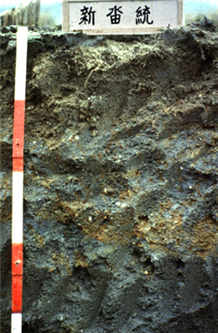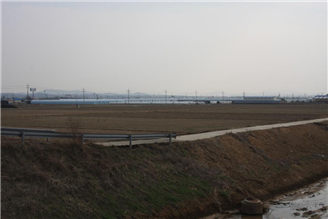

Morphological properties of typifying pedon.
|
|
SINDAB SERIES |
Established Series UKT, JFD 17 November, 1969 |
The Sindab series are members of the mixed, mesic family of Typic Psammaquents [Gleyic Hydragric Anthrosols (Eutric Arenic) classified by WRB]. These soils have gray to olive brown or dark grayish brown fine gravelly loamy coarse sand Ap horizons and fine gravelly coarse sand Cg horizons. They occur on level to very gently sloping alluvial plains and are mostly in granitic areas.
Typifying pedon: Sindab fine gravelly coarse sand-paddy rice (Field description Sangju Gun profile No. 196; colors are for moist soil).
Slope: 0-2%
Elevation: m above m.s.l.
Soil moisture regime: Aquic
Temperature regime: Mesic
Parent material: Alluvium
Diagnostic features: An ochric epipedon from a depth of 0 to 12 cm (An anthaquic horizon from a depth of 0 to 40 cm and a hydragric horizon from a depth of 40 to 80 cm by WRB).
|
|
|
|
|
Morphological properties of typifying pedon. |
||
Ap - 0 to 12 cm. Olive brown (2.5Y 4/4) fine gravelly coarse sand; common coarse faint grayish brown (2.5Y 5/2) mottles; structureless, single grained; loose, non sticky and non plastic; 20 percent quartz grits; common fine roots; gradual smooth boundary; pH 6.5. See remarks.
Cg1 - 12 to 40 cm. Olive gray (5Y 4/2) fine gravelly coarse sand; structureless, single grained; loose, non sticky and non plastic; 15 percent quartz grits; few fine roots; gradual smooth boundary; pH 6.0.
Cg2 - 40 to 80 cm. Light olive gray (5Y 6/2) fine gravelly coarse sand; structureless, single grained; loose, non sticky and non plastic; 10 percent quartz grits; few fine roots; diffuse smooth; pH 6.5.
Type Location: About 1 km. west of Geumgye (Ogsan village) Ri, Gongseong Myeon, Sangju Si, Gyeongsangbug Do.
Range in Characteristics: These soils have ochric epipedons. Depth over strongly contrasting layers is more than one meter and depth over hard rock is 3 to 5 meters. Base saturation is more than 60 percent. Reaction is medium to strongly acid. 10 to 35 percent quartz grit occurs throughout the profiles. Ap horizons are grayish brown, dark grayish brown, olive brown, gray, or light gray sand, loamy sand, coarse sand, or sandy loam. Cg horizons are commonly shades of gray, grayish brown, light olive gray, or dark gray fine gravelly sand, loamy sand, coarse sand, or loamy coarse sand. Thin strata of other textures may occur. In general, textures are coarser with depth.
Competing Series and Their Differentiae: These are the Hamchang, Geumji, Subug, Hwabong, Hwangryong, and Nagdong series. The Hamchang soils have coarse loamy textures. The Geumji soils are sandy skeletal texture family. The Subug soils have coarse loamy textures. The Gangdong soils are fine loamy over sandy texture family. The Hwabong soils have coarse sandy textures, lack gray colors and are somewhat excessively drained. The Hwangryong soils have sandy skeletal textures, lack gray mottles and are somewhat excessively drained. The Nagdong soils have fine sandy textures, lack gray mottles and are somewhat excessively drained.
Setting: The Sindab soils are formed in coarse textured sandy alluvium on alluvial plains, frequently in old stream channels and also in areas adjacent to dyked stream channels where the stream bed is higher than the alluvial plains. They also occur in narrow valley alluvium and below lakes commonly where seepage water and springs occur. Dominant slopes are about 1 percent and slope range is from 0 to 7 percent.
Principal Associated Soils: The Seongsan, Togye, Sangju, and Ibseog soils are associated in local alluvial positions above the Sindab soils. The Hwangryong and Hwabong soils are associated in river levee positions. The Samgag and Dosan soils are associated in residual upland positions.
Drainage and Permeability: Poorly drained. Permeability is very rapid and runoff is ponded or very slow. The ground water table is at or near the surface most of the year except where artificially controlled.
Use and Vegetation: Most areas are used for paddy rice.
Distribution and Extent: The Sindab soils are of moderate extent and are distributed along the main river and in local valley alluvial plains, mainly in granitic areas throughout the country.
Series Established: Ulju Gun, Gyeongsangnam Do, 1967.
Laboratory data sheets of typifying pedon.
|
Depth (cm) |
Horizon |
( --- Total ---) |
(-- Clay --) |
(-- Silt --) |
(------- Sand -------) |
||||||||
|
Clay |
Silt |
Sand |
Fine |
Coarse |
Fine |
Coarse |
VF |
F |
M |
C |
VC |
||
|
LT |
.002 |
.05 |
LT |
LT |
.002 |
.02 |
.05 |
.10 |
.25 |
.5 |
1 |
||
|
.002 |
- .05 |
- 2 |
.0002 |
.002 |
- .02 |
- .05 |
- .10 |
- .25 |
- .50 |
- 1 |
- 2 |
||
|
- - - - - - - - - - - Pct of ˂ 2mm (3A1) - - - - - - - - - - - |
|||||||||||||
|
0-12 |
Ap |
2.3 |
7.5 |
|
|
|
|
|
6.0 |
15.8 |
27.5 |
23.9 |
17.0 |
|
12-40 |
Cg1 |
2.1 |
5.4 |
|
|
|
|
|
5.4 |
12.8 |
25.0 |
27.0 |
22.3 |
|
40-80 |
Cg2 |
2.1 |
1.0 |
|
|
|
|
|
2.0 |
10.1 |
30.2 |
29.1 |
25.5 |
|
Depth (cm) |
Coarse Fractions(mm) |
˃2mm |
Orgn |
Total |
Extr |
Total |
(-- Dith -Cit --) |
|||||
|
Weight |
Wt |
C |
N |
P |
S |
Extractable |
||||||
|
2-5 |
5-20 |
20-75 |
.1-75 |
Pct of |
|
|
|
|
Fe |
Al |
Mn |
|
|
|
|
|
|
Whole |
6A1c |
6B3a |
6S3 |
6R3a |
6C2b |
6G7a |
6D2a |
|
|
Pct of ˂ 75mm (3B1) |
Soil |
Pct ˂ 2mm |
g/kg |
Pct of ˂ 2mm |
||||||||
|
0-12 |
|
|
|
|
|
0.42 |
|
|
|
|
|
|
|
12-40 |
|
|
|
|
|
0.23 |
|
|
|
|
|
|
|
40-80 |
|
|
|
|
|
0.06 |
|
|
|
|
|
|
|
Depth (cm) |
Ratio/Clay |
Atterberg |
( Bulk Density ) |
COLE |
(- Water Content -) |
WRD |
|||||||
|
CEC |
1500 |
Limits |
Field |
33 |
Oven |
Whole |
Field |
10 |
33 |
1500 |
Whole |
||
|
|
kPa |
LL |
PI |
Moist |
kPa |
Dry |
Soil |
Moist |
kPa |
kPa |
kPa |
Soil |
|
|
8D1 |
8D1 |
4P1 |
4P |
4A3a |
4A1d |
4A1h |
4D1 |
4B4 |
4B1c |
4B1c |
4B2a |
4C1 |
|
|
|
|
Pct ˂0.4mm |
- - g/cc - - |
cm/cm |
-- Pct of ˂2mm -- |
cm/cm |
|||||||
|
0-12 |
|
|
|
|
|
|
- |
|
|
13.5 |
9.8 |
2.9 |
|
|
12-40 |
|
|
|
|
|
|
1.64 |
|
|
9..5 |
7.2 |
2.1 |
|
|
40-80 |
|
|
|
|
- |
|
1.65 |
|
|
4.4 |
4.2 |
1.8 |
|
|
Depth (cm) |
( NH4OAc Extractable Bases ) |
Acid- |
Extr |
(----- CEC -----) |
Al |
||||||
|
Ca |
Mg |
K |
Na |
Sum |
ity |
Al |
Sum |
NH4- |
Bases |
Sat |
|
|
5B5a |
5B5a |
5B5a |
5B5a |
Bases |
|
|
Cats |
OAc |
+ Al |
|
|
|
6N2e |
6O2d |
6Q2b |
6P2b |
|
6H5a |
6G9a |
5A3a |
5A8b |
5A3b |
5G1 |
|
|
- - - - - - - - - - - - meq / 100g - - - - - - - - - - - - |
Pct |
||||||||||
|
0-12 |
1.80 |
0.60 |
0.13 |
0.10 |
|
|
|
|
2.10 |
|
|
|
12-40 |
1.20 |
0.60 |
0.13 |
0.08 |
|
|
|
|
2.20 |
|
|
|
40-80 |
0.85 |
0.35 |
0.08 |
0.08 |
|
|
|
|
1.50 |
|
|
|
Depth (cm) |
(Base Sat) |
CO3 as |
Res |
Cond |
(------ pH ------) |
Acid Oxalate Extraction |
|||||||
|
Sum |
NH4- |
CaCO3 |
|
|
NaF |
KCl |
CaCl2 |
H2O |
Opt |
Al |
Fe |
Si |
|
|
|
OAc |
˂2mm |
|
|
|
|
.01M |
|
Den |
|
|
|
|
|
5C3 |
5C1 |
6E1g |
8E1 |
8I |
8C1d |
|
8C1f |
8C1f |
8J |
6G12 |
6C9a |
6V2 |
|
|
---- Pct ---- |
ohms/cm |
dS/m |
|
1: 1 |
1: 2 |
1: 1 |
|
- Pct of ˂2mm - |
|||||
|
0-12 |
|
127.6 |
|
|
|
|
5.1 |
|
6.3 |
|
|
|
|
|
12-40 |
|
91.4 |
|
|
|
|
4.2 |
|
5.3 |
|
|
|
|
|
40-80 |
|
90.7 |
|
|
|
|
3.9 |
|
4.6 |
|
|
|
|
|
Depth (cm) |
Elemental Analysis of Clay |
3/ |
Free |
Mn |
||||||
|
H2O |
Igni |
SiO2/ |
SiO2 |
Fe2O3 |
Al2O3 |
K2O |
CEC |
Fe2O3 |
|
|
|
% |
loss % |
R2O3 |
% |
% |
% |
% |
me/100g |
% |
ppm |
|
|
0-12 |
|
10.69 |
2.52 |
49.59 |
3.48 |
29.95 |
0.89 |
|
0.16 |
10.4 |
|
12-40 |
|
10.82 |
2.23 |
46.98 |
5.56 |
32.25 |
1.86 |
|
0.16 |
12.8 |
|
40-80 |
|
- |
- |
- |
- |
- |
- |
|
- |
- |